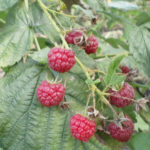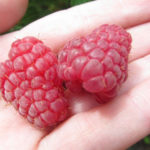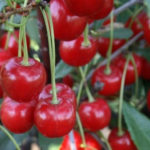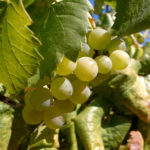Gooseberry variety Grushenka
In recent decades, the hobby for gooseberries among gardeners in Russia has become almost ubiquitous. This is facilitated by the emergence of new studless varieties, which, moreover, look aesthetically pleasing. Such promising varieties include Grushenka. Although the species is not listed in the State Register, it is popular among gardeners, and deservedly so. It was created at the All-Russian Institute of Selection and Technology for Horticulture and Nursery as a result of hybridization of varieties Northern Captain x Moscow Red x GF 595 33. The variety has prospects not only for amateur cultivation, but also for industrial. Perfect for the climatic conditions of central Russia.

Description
Grushenka's bush is medium-sized, about 1 meter high. At a young age, it is broadly spreading due to the tendency of the branches to practically lie down on the ground. But after 3 - 4 years the situation changes, the gooseberry bush becomes more compact, slightly spreading. Young shoots of medium thickness grow quickly and in large numbers, giving the plant an increased density. Annual branches are well branched. There are practically no thorns on them. The internodes are shortened. Strongly leafy bush. Leaves are of normal size, round, five-lobed, bright green, smooth, with a glossy surface. The middle blade rises slightly above the lateral ones. The tops of the lobes are slightly elongated, the denticles are not bent. Inflorescences are one-, two- or three-flowered, they are laid in large quantities along the shoot, which is why during the harvest period Grushenka is simply hung with berries, like beads, and looks very attractive. The gooseberry crop is formed along the entire length of last year's growth and two-year branches.
The fruits of the variety are round-elongated, pear-shaped. The skin is thick, dense, smooth. At the time of ripening, the color changes from light red to deep purple, almost black. There is a thick waxy coating of a bluish tint. Small, medium and large fruits can ripen on the bush. The average weight of fruits is 4.3 grams, but there are 6 and 8 grams. The taste is refreshing, pleasant, sweet and sour. But the assessment of the tasters ranges from 4.1 to 5 points. The pulp is juicy, aromatic, the seeds are small, in moderation. Berries are high in pectins and anthocyanin compounds.

Characteristics
- During the fruiting period, Grushenka enters 2 - 3 years after planting, which is an indicator of the early maturity of the culture. But you can get acquainted with the taste of the variety the next year after planting a two-year-old seedling, when the first gooseberry appears, albeit in small quantities;
- the ripening period is medium late, the first fruits can be picked at the end of July, but the massive harvest begins in the first half of August;
- the variety does not suffer from spring frosts, therefore, returning cold does not threaten the plant blooming in May;
- the yield is stable, annual. Up to 6 kg of berries are harvested from the bush;
- in one place the plant bears fruit for 15 - 20 years;
- ripe berries hold tightly to the branches, do not crumble;
- winter hardiness is very good. Without shelter, even in snowless winters, the plant calmly tolerates frosts at -30 ° C;
- the culture is heat-resistant and easily survives dry periods;
- Grushenka's immunity is very high. Gooseberry has excellent resistance to powdery mildew, is not afraid of spheroteka, septoria, viral diseases;
- the variety has a very high transportability. Keeping temperature at 90% humidity and 0 ° C can last up to a month or more;
- the way of eating fruits is universal. They are used in their natural form as a dessert, suitable for processing into preserves, jam, marmalade, baking stuffing.
Planting and agricultural technology
The variety can be planted in spring or autumn, after preparing the soil. Choose a sunny site so that more sugars accumulate in the berries. From soils, the culture prefers loose and nutritious loams with neutral acidity. The level of subsoil waters should be no higher than 1.2 meters to the surface, otherwise the root system of a young plant will suffer greatly, and in the future, high humidity can contribute to the development of fungal infections. In adulthood, Grushenka acquires a fairly powerful root system that can maintain vitality during dry periods. During the growing season, the plant needs to be watered about 3-4 times. The size of gooseberry berries will be favorably influenced by moisture applied immediately after flowering and during the period of ovary formation. The culture is responsive to feeding. An important step in growing is pruning. To avoid increased thickening, it is necessary to regulate the number of shoots by removing old branches and excess zero shoots. At the time of fruiting, the branches can droop under the weight of the fruit, so you need to prepare supports in advance. The rest of the agricultural technology is common.
Grushenka is a promising, unpretentious variety that delights the gardener with an excellent harvest and aesthetic appearance. High immunity and excellent frost resistance allow growing crops even in unfavorable regions. The absence of thorns ensures trouble-free harvesting. No significant flaws were found in gooseberries, except for the requirements for the presence of support and the need for annual pruning.









I got this gooseberry from a neighbor in the garden. I took it with pleasure, rather, even asked for it myself. Firstly, the purple color of the berries has always attracted me. It seems that these berries are sweeter than green ones. The second thing for which I fell in love with Grushenka is that she is practically without thorns! The gooseberry has already taken root in me, it tolerates both frosty winters well and dry times. I can only get into the garden on weekends. So he is always waiting for me: and the berries do not really crumble even when fully ripe. I use berries to make jam.
Good day! Tell me, is this variety self-fertile or not? Does he need pollinators? or will one in the garden give berries?